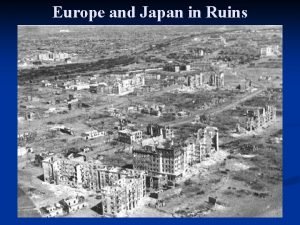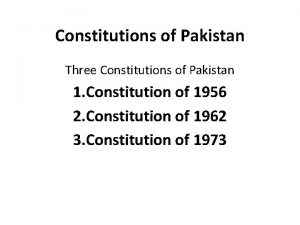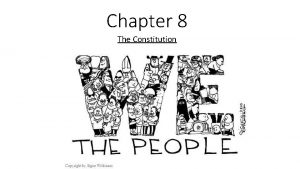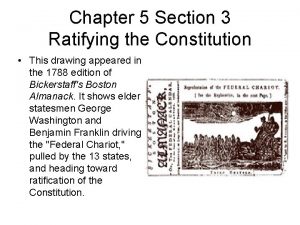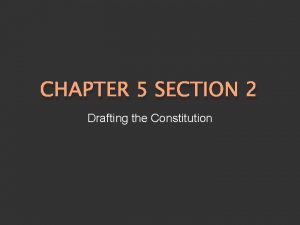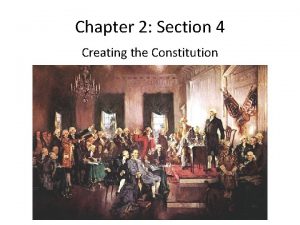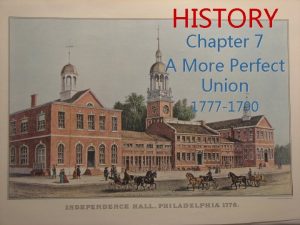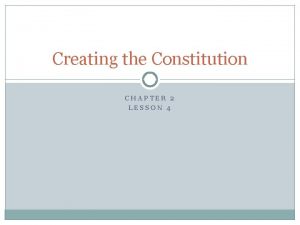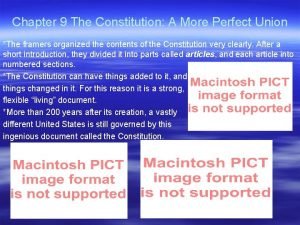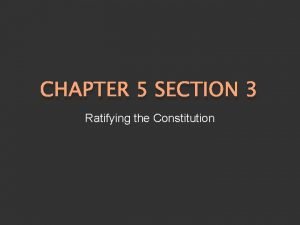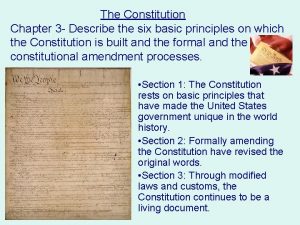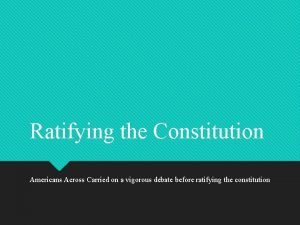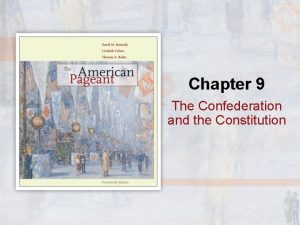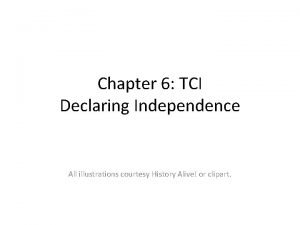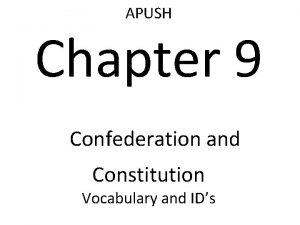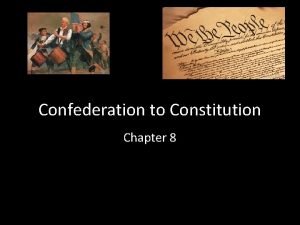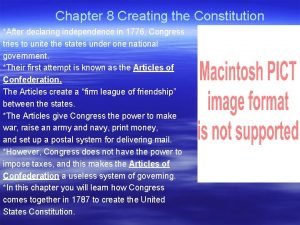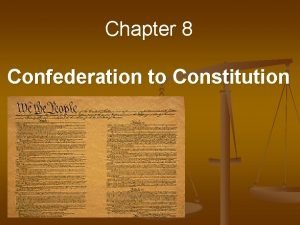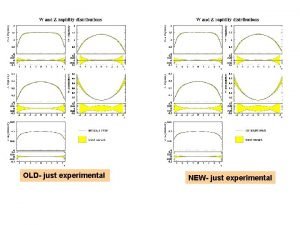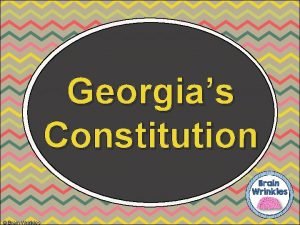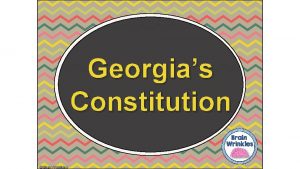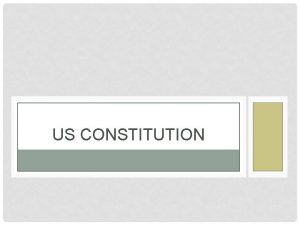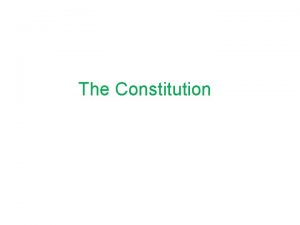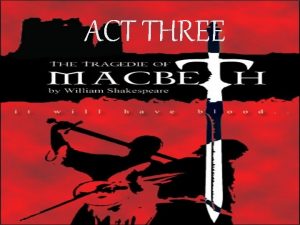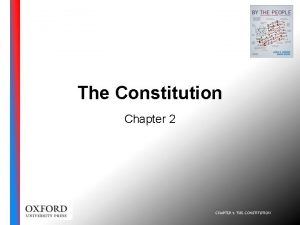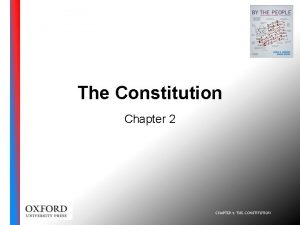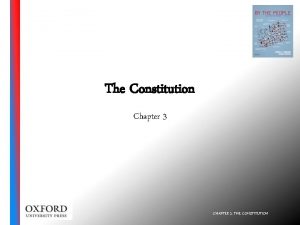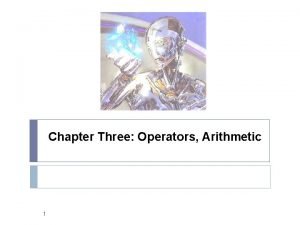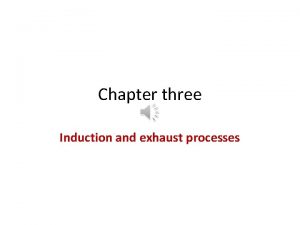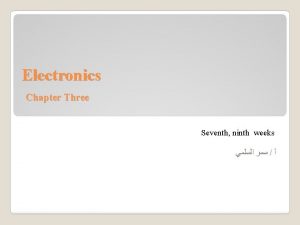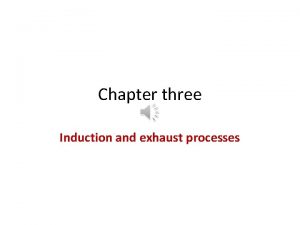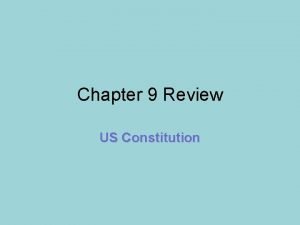Chapter Three The Constitution The Constitution Is just


































- Slides: 34

Chapter Three The Constitution

The Constitution • Is just 4, 300 words long. • Divides the national government into three branches • Describes the powers of those branches and their connections Copyright © Houghton Mifflin Company. All rights reserved. 2

The Constitution (Cont’d) • Outlines the interaction between the government and the governed • Describes the relationship between the national government and the states. • Is the supreme law of the land. Copyright © Houghton Mifflin Company. All rights reserved. 3

The Revolutionary Roots of the Constitution • American colonists in the eighteenth century enjoyed a degree of freedom denied most people at the world, but at a high cost. • Thomas Jefferson took the first official step toward revolution and independence by patterning the Declaration of Independence after John Locke’s writings. Copyright © Houghton Mifflin Company. All rights reserved. 4

The Revolutionary Roots of the Constitution (Cont’d) • A republic was fashioned, which is a government system based upon the consent of the governed, whose power is exercised by representatives who are responsible to them. Copyright © Houghton Mifflin Company. All rights reserved. 5

The Revolutionary Roots of the Constitution (Cont’d) • The Articles of Confederation created a confederative form of government that comprises a loose collection of independent state governments that agree to cooperate on specified matters. Copyright © Houghton Mifflin Company. All rights reserved. 6

The Revolutionary Roots of the Constitution (Cont’d) • Each state has supreme power within its borders. • The central government is weak in that it cannot control the actions of sovereign states. Copyright © Houghton Mifflin Company. All rights reserved. 7

The Revolutionary Roots of the Constitution (Cont’d) • The Articles of Confederation failed because: • The national government had no power to tax, • There was no independent leadership position to direct the government, • The national government could not regulate interstate and foreign commerce, and • The Articles of Confederation could not be amended without the unanimous agreement of the congress and assent of all state legislatures. Copyright © Houghton Mifflin Company. All rights reserved. 8

From Confederation to Constitution • Virginia Plan provisions: 1. Three separate branches of government: legislative, executive, and judicial 2. A two-house legislature, the lower house chosen by popular election and the upper house chosen from candidates nominated by state legislatures Copyright © Houghton Mifflin Company. All rights reserved. 9

Virginia Plan Provisions (Cont’d) 3. Each state’s representation in the lower house would be determined in proportion to the taxes it paid to the national government or in proportion to its free population. 4. An executive, consisting of an unspecified number of people, be selected by the legislature and serve for a single term. Copyright © Houghton Mifflin Company. All rights reserved. 10

Virginia Plan Provisions (Cont’d) 5. The national judiciary should include one or more supreme courts and other lower courts, with judges appointed for life by the legislature 6. That the executive and a number of national judges serve as a council of revision, to approve or veto legislative acts, subject to override by a vote of both houses of the legislature Copyright © Houghton Mifflin Company. All rights reserved. 11

Virginia Plan Provisions (Cont’d) 7. That the scope of powers of all three branches be far greater than the previous powers under the Articles of Confederation and that the legislature be empowered to override state laws. Copyright © Houghton Mifflin Company. All rights reserved. 12

From Confederation to Constitution • New Jersey Plan provisions: • A single-chamber legislature have the power to raise revenue and regulate commerce, • That the states have equal representation in the legislature and choose its members, • That a multiperson executive be elected by the legislature, with powers similar to those in the Virginia Plan, but without the right to veto legislation, Copyright © Houghton Mifflin Company. All rights reserved. 13

New Jersey Plan Provisions (Cont’d) • That a supreme tribunal be created, with limited jurisdiction (no national court system), and • That the acts of the legislature be binding on the states with the option of force to compel obedience. Copyright © Houghton Mifflin Company. All rights reserved. 14

The Great Compromise Provisions • Representation in the House of Representatives would be apportioned according to the population of each state (initially consisting of 56 members), • Revenue-raising acts would originate in the House Copyright © Houghton Mifflin Company. All rights reserved. 15

The Great Compromise Provisions (Cont’d) • Each state would be represented equally in the Senate (2 each) • Senators would be selected by their state legislatures, not by direct popular election. Copyright © Houghton Mifflin Company. All rights reserved. 16

The Final Product • The basic principles establishing a revolutionary new political order were: • Republicanism: a form of government in which power resides in the people and is exercised by their elected representatives. • Federalism: a form of government dividing power between a central government and regional units. Copyright © Houghton Mifflin Company. All rights reserved. 17

The Final Product (Cont’d) • Separation of Powers: The assignment of the lawmaking, law-enforcing, and lawinterpreting functions of government to independent legislative, executive, and judicial branches. This concept safeguards liberty by ensuring that all government power does not fall into the hands of a single person or group of people. Copyright © Houghton Mifflin Company. All rights reserved. 18

The Final Product (Cont’d) • Checks and Balances: a means of giving each branch of government some scrutiny of and control over the other branches. The aim is to prevent the exclusive exercise of certain powers by any one of the three branches. Copyright © Houghton Mifflin Company. All rights reserved. 19

Figure 3. 2: Separation of Powers and Checks and Balances Copyright © Houghton Mifflin Company. All rights reserved. 20

The Final Product (Cont’d) • Seven articles of the Constitution • 1 -3: Establish the separate branches of government and specify their internal operations and powers. • 4 -7: Define the relationships among the states, explain the process of amendment, declare the supremacy of national law, and explain the procedure for ratifying the Constitution. Copyright © Houghton Mifflin Company. All rights reserved. 21

Article I • Section 8 establishes the principle of Enumerated Powers in which Congress may exercise only the powers that the Constitution assigns to it by the “necessary and proper clause. ” • The last clause of Section 8, the “necessary and proper clause, ” also establishes Congress’ implied powers—powers that Congress needs to execute its enumerated powers. Copyright © Houghton Mifflin Company. All rights reserved. 22

Article II • Establishes: • President’s term of office • Procedure for electing the president through the electoral college • Qualifications for becoming president • President’s duties and powers. Copyright © Houghton Mifflin Company. All rights reserved. 23

Figure 3. 1: The Constitution and the Electoral Process Copyright © Houghton Mifflin Company. All rights reserved. 24

Article III • The Judicial Article • Left purposely vague due to disagreement over its provisions and thus Congress established a system of federal courts, separate from state courts. • Does not explicitly give the courts the power of judicial review or the authority of the court to invalidate congressional or presidential actions. Copyright © Houghton Mifflin Company. All rights reserved. 25

Article IV • Requires that the judicial acts and criminal warrants of each state be honored in all other states • Forbids discrimination against citizens of one state by another state. • Allows the addition of new states and stipulates that the national government will protect the states against foreign invasion and domestic violence. Copyright © Houghton Mifflin Company. All rights reserved. 26

Article V • Specifies the method for amending the Constitution Copyright © Houghton Mifflin Company. All rights reserved. 27

Article VI • Supremacy Clause: • Asserts that when they conflict with state or local laws, the Constitution, national laws and treaties take precedence. Copyright © Houghton Mifflin Company. All rights reserved. 28

Article VII • Describes the ratification process, stipulating that approval by conventions in nine states would be necessary for the Constitution to take effect. Copyright © Houghton Mifflin Company. All rights reserved. 29

Selling the Constitution • Federalists and Anti-federalists debated the merits of the new Constitution, as evidenced by the writings contained in the Federalist papers. Copyright © Houghton Mifflin Company. All rights reserved. 30

The Bill of Rights • First ten amendments to the federal constitution: • Restrain the national government from tampering with fundamental rights and civil liberties • Emphasize the limited character of the national government’s power Copyright © Houghton Mifflin Company. All rights reserved. 31

Constitutional Change • The formal amendment process to the Constitution requires a two-stage process, proposal and ratification. Both are necessary for an amendment to become part of the Constitution. Copyright © Houghton Mifflin Company. All rights reserved. 32

Figure 3. 3: Amending the Constitution Copyright © Houghton Mifflin Company. All rights reserved. 33

Constitutional Change (Cont’d) • Interpretations of the Constitution by the courts and political practice have also influenced the meaning and application of provisions of the Constitution. Copyright © Houghton Mifflin Company. All rights reserved. 34
 Texas constitution vs us constitution
Texas constitution vs us constitution Nc constitution vs us constitution
Nc constitution vs us constitution Constitution what is constitution
Constitution what is constitution Lesson 1 principles of the constitution
Lesson 1 principles of the constitution Did paris love juliet?
Did paris love juliet? Note 3 ways war affected the land
Note 3 ways war affected the land 3 constitutions of pakistan
3 constitutions of pakistan Becoming a millionaire chapter 3 lesson 2
Becoming a millionaire chapter 3 lesson 2 Lesson 1 structure and principles of the constitution
Lesson 1 structure and principles of the constitution Chapter 5 section 3 ratifying the constitution answer key
Chapter 5 section 3 ratifying the constitution answer key Chapter 5 section 2 drafting the constitution
Chapter 5 section 2 drafting the constitution Chapter 2 section 4 creating the constitution
Chapter 2 section 4 creating the constitution Chapter 7 lesson 2 forging a new constitution
Chapter 7 lesson 2 forging a new constitution Chapter 2 lesson 4 creating the constitution
Chapter 2 lesson 4 creating the constitution Chapter 9 the constitution a more perfect union
Chapter 9 the constitution a more perfect union Ratifying the constitution chapter 5 section 3
Ratifying the constitution chapter 5 section 3 Chapter 3 section 1 constitution scavenger hunt answers
Chapter 3 section 1 constitution scavenger hunt answers Chapter 5 section 3 ratifying the constitution answer key
Chapter 5 section 3 ratifying the constitution answer key Chapter 9 the confederation and the constitution
Chapter 9 the confederation and the constitution Tci chapter 8 - creating the constitution answer key
Tci chapter 8 - creating the constitution answer key Chapter 9 confederation and constitution
Chapter 9 confederation and constitution Chapter 8 confederation to constitution
Chapter 8 confederation to constitution Chapter 8 creating the constitution
Chapter 8 creating the constitution Chapter 8 confederation to constitution
Chapter 8 confederation to constitution Hình ảnh bộ gõ cơ thể búng tay
Hình ảnh bộ gõ cơ thể búng tay Ng-html
Ng-html Bổ thể
Bổ thể Tỉ lệ cơ thể trẻ em
Tỉ lệ cơ thể trẻ em Chó sói
Chó sói Tư thế worm breton
Tư thế worm breton Hát lên người ơi alleluia
Hát lên người ơi alleluia Các môn thể thao bắt đầu bằng tiếng bóng
Các môn thể thao bắt đầu bằng tiếng bóng Thế nào là hệ số cao nhất
Thế nào là hệ số cao nhất Các châu lục và đại dương trên thế giới
Các châu lục và đại dương trên thế giới Công thức tính độ biến thiên đông lượng
Công thức tính độ biến thiên đông lượng





